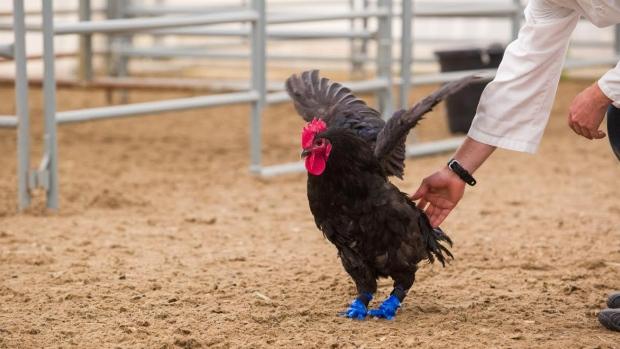
When Foghorn the rooster lost his feet to frostbite in Calgary Canada, many people would have believed his strutting days were over. However, he was lucky enough to have been rescued by Calgary Animal & Bylaw Services where his plight came to the attention of Dr. Daniel Pang, Assistant Professor of Calgary Faculty of Veterinary Medicine (UCVM) who took the bird under his wing, so to speak.
Pang turned to Dr. Mark Ungrin, also an assistant professor at UCVM as he had heard of his work prototyping and simulating body parts through 3D printing. Given the location of his work, within a school of veterinary medicine, Ungrin  didn’t bat an eye when the idea was presented to him to create a pair of 3D printed feet for Foghorn. He discussed the framework for the project:
didn’t bat an eye when the idea was presented to him to create a pair of 3D printed feet for Foghorn. He discussed the framework for the project:
“We have mostly focused on the development of teaching simulators, to give veterinary students something to practice on without needing to work on a live animal. But you can imagine there is a lot of overlap between making imitation body parts for vets to train with, and making imitation body parts for the animal to use as we have here.”
In what might go down in history as the most entertaining homework assignment to ever have to explain to someone else, undergraduate mechanical engineering student in Biomedical Engineering at the Schulich School of Engineering set about working to make Foghorns new feet. Condor explained the process:
“I went and got some molds of his stubs and scanned them to make a computer model. I got my hands on some wild turkey feet and used the scanner for that as well and matched them up to get a negative of the foot stump. Then I printed off the stumps and printed off the new feet and painted them with silicone so they’d be sturdy but flexible and soft for the rooster.”
Finally, a use for those wild turkey feet I have in the freezer!
But nature makes the tricky seem simple and so it takes a great deal of work to try and replace her handiwork. In this case, Kondro found that Rooster Feet version 1.0 was less than ideal:
“The first ones didn’t work. He couldn’t really walk and kept falling over so I was pretty disappointed. So I made version 2.0 and I strapped the feet onto him. It was pretty exciting to see him strut around.”
As comical as the idea might sound, it has significant real world implications both in terms of the creation of prosthetics and the demonstration of the interdisciplinary of these types of complex projects. Dr. Ungrin discussed the nature of the collaboration:
“This was a very interdisciplinary project. Dr. Pang is my veterinarian, my background is cell biology and tissue engineering, and my student Doug is working towards a degree in Mechanical Engineering. Given that this is not our major research focus, the fact that we were able to come together quickly, find a solution and implement it without drawing unduly on anyone’s time was really a function of having the connections in place ahead of time. It also helps that Doug has a lot of energy and is willing to jump into new things with both feet.”
It becomes easier to forgive the bad pun when you realize that the rooster is now footloose and fancy free on a farm in Alberta thanks to their efforts.
Let us know your thoughts on yet another happy animal thanks to 3D printing. Discuss in the 3D Printed Rooster Feet forum thread on 3DPB.com. Check out the video describing the entire process below:
Subscribe to Our Email Newsletter
Stay up-to-date on all the latest news from the 3D printing industry and receive information and offers from third party vendors.
You May Also Like
NSF Awards Kentucky $1M for Advanced Manufacturing
The National Science Foundation has awarded a $1 million grant to the University of Louisville for the Advancing Manufacturing and Building Construction Technologies (NSF AMT) project. This initiative is part...
3D Printing News Briefs, May 11, 2024: 3D Printed Stent, Tower, Sculptures, & More
We’re starting off with medical research in today’s 3D Printing News Briefs, as researchers in Korea used CT images and 3D printing to fabricate an educational simulator for a mastoidectomy....
3D Printing Unpeeled: Wind Turbines, Probiotics and Lenses
TPI Composites, ORNL and Ingersoll Rand are working to make wind turbine tooling segments that can be 18.3 meters long. These elements also include resistive wires that help keep the...
Tethon 3D Releases Cost-effective Bioprinter
Tethon 3D, known for its ceramic-loaded DLP materials, custom resins, and DLP 3D printers, has recently released a bioprinter. Vat polymerization printers like DLP systems have been widely used by...
































